|
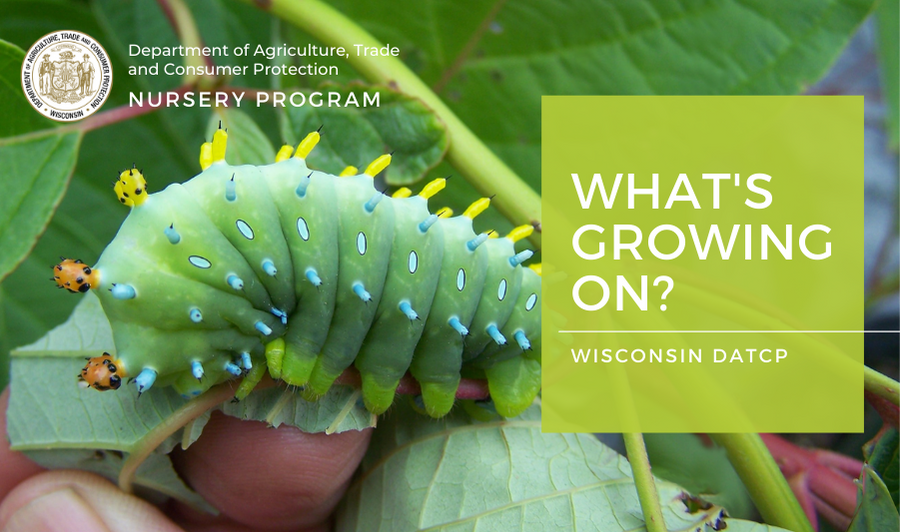 _____________________________________
Dear Wisconsin nursery owners, Christmas tree growers, and gardeners:
We hope you are enjoying the beautiful fall colors that are on display across the state. As the growing season winds down, you can check out DATCP survey summaries from the growing season. Simple base 50 growing degree day accumulations as of October 13th were 1812 in Bayfield, 1926 in Medford, 2140 in Wausau, 2389 in Hancock, 2612 in Green Bay, 2766 in Racine, 2775 in Madison, and 2819 in La Crosse.
Take a moment to read through a few updates from the DATCP nursery program. Please send any feedback, questions, or ideas for future e-news updates to datcpnursery@wisconsin.gov.
Having trouble viewing this email? View it as a Web page.
_____________________________________
|
|
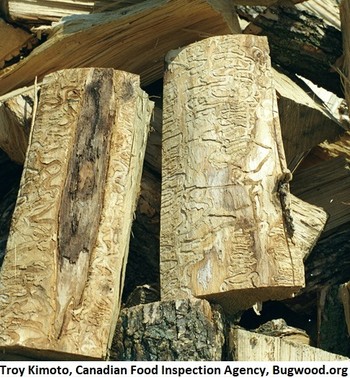
Did you know that seemingly harmless pieces of firewood could be harboring tree-killing insect pests and diseases? In honor of National Firewood Awareness Month, make sure to know what could be growing on or in firewood.
If handling firewood from an oak tree that may have died recently from an oak wilt infection, there could be oak wilt fungal mats under the bark. Oak wilt is a fungal disease that is especially deadly to oaks in the red oak group (red, black, pin oaks with bristles or points on the leaf lobes). Once inside an oak, the fungus triggers a reaction that shuts down the tree’s plumbing, causing the tree to wilt and die in a matter of weeks. If there is a possibility that oak firewood came from a tree recently killed by oak wilt, moving that firewood is not recommended as it could move viable fungal spores into areas that are not yet affected by oak wilt.
It is also possible that your firewood may have been chosen by a female spongy moth as an ideal egg-laying spot. Female spongy moths will lay caramel-colored fuzzy, spongy egg masses at the end of the summer on just about anything outdoors. If that happens to be on firewood, you could inadvertently move an egg mass with up to 1,000 unhatched caterpillars within to an area with lots of edible tree and shrub foliage. Repeated defoliation from spongy moth can make deciduous trees and conifers vulnerable to other harmful agents like tree borers and root rot. That is why it is crucial to inspect firewood for egg masses and never move uncertified firewood out of the 52 counties that are quarantined for spongy moth.
Other insects, like Emerald Ash Borer and Asian Longhorned Beetle, could be tunneling around under the bark or deep within pieces of clean-looking firewood. The movement of infested ash firewood is one of the reasons that the Emerald Ash Borer was able to spread so quickly across the Midwest and eastern U.S. and kill millions of ash trees.
When in doubt about what could be growing on or in: Do not move firewood and instead, buy it at your destination. Hundreds of firewood sales locations can be found at FirewoodScout.org. Another good option is to buy DATCP and/or USDA certified firewood, which has been treated to reduce the risk of transporting tree-killing pests.
|
_____________________________________
|
|
|
Top (left) and bottom (right) of a crabapple leaf with Japanese apple rust | DATCP collaborator image
This summer, DATCP pest survey staff conducted a federally funded risk based nursery pathway survey at 17 nursery and garden center locations across 10 south central and southeastern Wisconsin counties. The purpose of this survey was to increase surveillance of 19 priority pests of national and state concern from entering the state through the nursery trade (Table 1). DATCP staff conducted a combination of visual and trapping surveys of targeted host plants April through August. Survey sites were visited biweekly to collect trap catch and sample any symptomatic host material, with subsequent sample processing and final determinations made upon analysis in the Plant Industry Bureau (PIB) Laboratory.
Seventy-eight pheromone baited insect traps were set across the 17 survey locations and 410 samples collected during the June to August survey window. Trap catch sample screening for target pests is ongoing at the PIB Laboratory, with 90% of sample processing complete and no insect target pests found to date.
A total of 18 symptomatic plant samples were collected as a result of visual surveys, including 17 suspect disease samples and one suspect insect pest target. Laboratory analysis confirmed one target pathogen, Gymnosporangium yamadae (the fungus that causes Japanese apple rust), at three sites located in Dane and Sheboygan counties as part of this survey. In addition to the confirmation of this pathogen on nursery stock, the Sheboygan County location also detected the pathogen on an established crabapple growing in the parking lot, suggesting that this pest may have already spread beyond the nursery environment at this site. Other non-target pathogens identified from samples submitted as part of this survey included Volutella bight (Volutella buxi) on boxwood, Fusarium blight (Fusarium sp.) on boxwood, and Gymnosporangium rust (Gymnosporangium sp. other than G. yamadae) on apple.
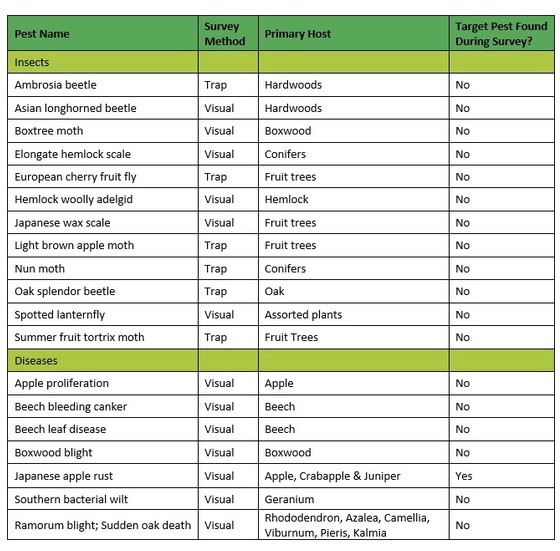 Table 1. List of target pests included in 2022 Nursery and Retail Plants Pest Survey.
_____________________________________
|
|
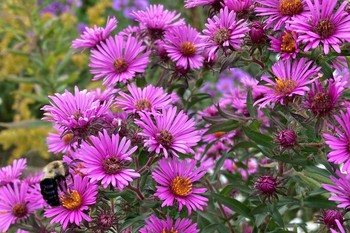
In the winter, native bees in Wisconsin nest in places like stems, underground, and in cavities. Many of these nesting locations can easily be incorporated into your garden. These efforts support Wisconsin pollinators, the crops they pollinate and other wildlife.
Fall cleanup activities:
- Conduct a pollinator habitat assessment, and repeat as needed.
- Leave pithy stemmed plants standing (no need to tie them up) to provide future nesting locations for stem nesting bees. (Pithy stemmed plants for Wisconsin include Echinacea, Sunflowers (all Helianthus), Bee balm, Goldenrods, Asters, etc.)
- Leave areas of bare, untilled soil and avoid pesticides. Ground nesting bees may use these areas and are impacted by pesticide residue, tillage, or digging.
- Support cavity nesting bees by providing nesting sites:
- Leave the leaves. Select areas of the garden, especially areas of native ground covers like wild geranium, wild ginger, etc., or a designated part of the garden where leaves can be left through the entire year.
- Place locally sourced logs or rock piles. Drill holes into a log or use local logs that already have holes made by borer beetles. Rock piles can be piled as a decorative element in a garden bed. A dry-stacked (non-mortar) rock wall could also provide suitable habitat.
- Use signage (including DIY) or garden art to let neighbors know the garden supports pollinators.
- Mown edges or paths and selective use of lawn indicate that the garden is well tended.
Planning for later:
- Watch for pollinators and consider signing up for projects.
- Avoid pesticide use in pollinator gardens.
- In the spring, trim pithy stemmed plants to a variety of heights (e.g., 6”, 8”, and 12”). This provides ideal nesting sites for next fall.
- Avoid tillage or digging in the areas of bare soil reserved for ground nesting bees.
- Continue to let the fallen leaves lie, at least in the designated areas.
Resources: Nesting & Overwintering Habitat for Pollinators & Other Beneficial Insects (xerces.org), Xerces Society Video: Habitat for Pollinators: Getting Ready for Winter - YouTube, Save the Stems (xerces.org), Create Nesting Habitat | University of Minnesota Bee Lab (umn.edu), Xerces Society Video: Bring Back the Pollinators: Providing Nest Habitat for Bees - YouTube, Planting For Pollinators (state.mn.us)
|
_____________________________________
|
|
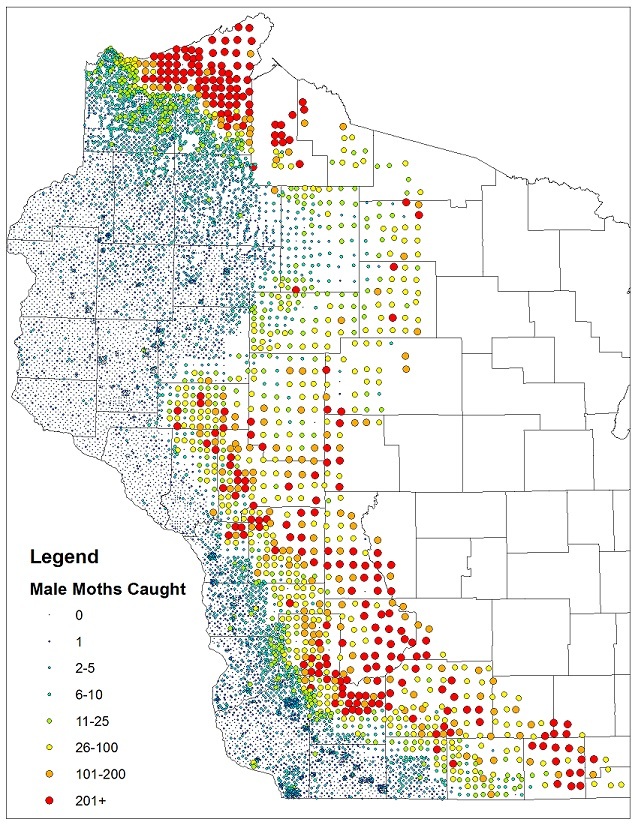 2022 Spongy Moth Trapping Results | DATCP M. Falk
In 2022, the Wisconsin Spongy Moth Program set 10,044 traps in 47 counties spanning central to western Wisconsin. All counts to follow are unofficial as final data is still coming in.
Total male spongy moth catches increased throughout Wisconsin, marking a third consecutive year of population growth. Preliminary analyses of 99.3% of trapping sites indicate statewide male moth totals increased by ~91% from 99,647 total moths (9.2 moths/trap) in 2021 to 190,492 total moths (19.0 moths/trap) in 2022. The majority of these trap catches were recorded in the central-eastern parts of the state that have historically experienced spongy moth infestations.
Increases in 2022 Wisconsin moth trap catches, though substantial, exemplify typical cycles of population fluctuation that are well-documented in areas where spongy moth has established. Aerial surveys by the WI DNR found moderate to heavy defoliation by spongy moth in the Kettle Moraine region in the southeast and the Bayfield Peninsula. The spread of spongy moth into relatively uninfested areas did not follow a uniform pattern, exhibiting moderate expansion in southwestern and northwestern corners of the state, and retraction throughout the west-central region. Follow up egg mass surveys scheduled for fall 2022 will help determine whether these patterns reflect the westward spread of persistent populations, or a spillover of transient male moths from more heavily infested areas to the east.
_____________________________________
|
|
 Restored Oak Savanna in Wisconsin | Wisconsin NRCS
USDA Natural Resources Conservation Service (NRCS) announced that growers, farmers and forest landowners interested in Environmental Quality Incentives Program (EQIP) or Regional Conservation Partnership Program (RCPP) producer contracts need to apply by November 4, 2022, for funding in fiscal year 2023.
Although NRCS accepts applications year-round, apply now for fiscal year 2023 funding consideration. Applications are being taken at all USDA Service Centers in Wisconsin. Applications received after November 4th, will automatically be deferred to the next funding cycle.
EQIP and RCPP are the primary programs available to farmers and landowners for farm and woodland conservation work, offering payments for more than 120 conservation practices. Last year, Wisconsin NRCS invested $34 million in conservation practices through EQIP and RCPP practices.
RCPP projects vary by year, so check annually to see if you can apply to participate in a project that covers your geographic area. A couple examples of conservation practices that growers could incorporate into their land management include: brush management; a conservation practice used if landowners have issues with woody invasive species. If landowners have soil erosion or water quality issues, there are a multitude of practices available to resolve those issues as well.
As American agriculture continues to grow in new directions, NRCS conservation assistance is growing along with it. To encourage and support urban agriculture in state, Wisconsin will offer targeted funding to support Urban Agriculture and Forestry producers
Landowners interested in applying for EQIP or RCPP funding should contact their local NRCS office at the USDA Service Center for their county. For more information, visit www.wi.nrcs.usda.gov.
_____________________________________
|
|
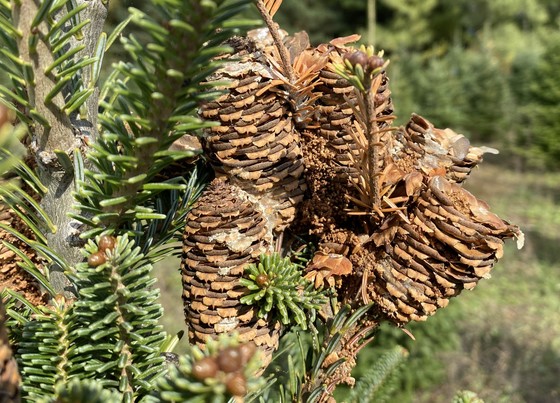 Fir Coneworm damage on fraser fir cones | DATCP L. Meils
During recent Christmas tree field inspections in Lincoln, Marinette, Marquette and Waushara counties, inspectors collected fir coneworm larvae from balsam and fraser fir cones. This native insect prefers feeding in cones, however it is sometimes found tunneling in twigs and terminal shoots of balsam and Fraser fir trees. In one occasion, it was also found infesting white pine whorls.
The fir coneworm life cycle can be quite variable. Adult fir coneworm moths may be present in the landscape from June through August. The adults lay eggs under cone scales or bark. The larvae are present from approximately late June through September. Larvae then drop to the ground to overwinter as pre-pupae in the soil.
During the fall, Christmas tree growers can dissect cones to inspect for the presence of this pest in or near their fields. Cones inhabited by the coneworm larvae will contain frass and webbing. Boring and tunneling through the cone scales is also readily visible.
Wisconsin Christmas tree producers reported significant fir coneworm damage to terminal shoots in transplants and young stock in 2018, however trees readily recovered from this damage during the following growing seasons. Fir coneworm is of greatest concern to growers who have seed orchards.
Preventative treatments may be warranted to protect new transplants, targeting adult moths from June through August. Growers can target larvae by removing cones in the summer as well as reducing the duff layer that protects overwintering caterpillars.
_____________________________________
|
|
|
|
|